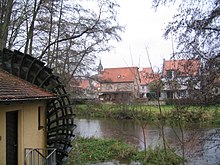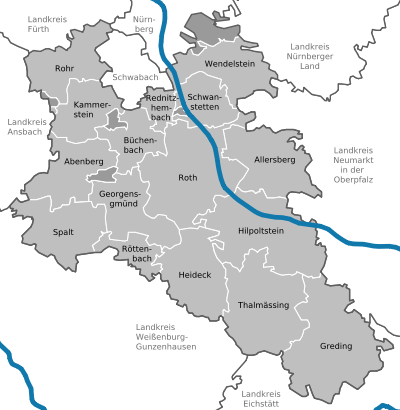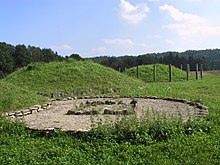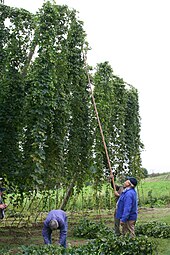District of Roth
| coat of arms | Germany map |
|---|---|

|

Coordinates: 49 ° 12 ' N , 11 ° 7' E |
| Basic data | |
| State : | Bavaria |
| Administrative region : | Middle Franconia |
| Administrative headquarters : | Roth |
| Area : | 895.39 km 2 |
| Residents: | 126,749 (Dec. 31, 2019) |
| Population density : | 142 inhabitants per km 2 |
| License plate : | RH, HIP |
| Circle key : | 09 5 76 |
| NUTS : | DE25B |
| Circle structure: | 16 municipalities |
| Address of the district administration: |
Weinbergweg 1 91154 Roth |
| Website : | |
| District Administrator : | Herbert Eckstein ( SPD ) |
| Location of the district of Roth in Bavaria | |
The district of Roth is located in the southeast of the Bavarian administrative district of Middle Franconia . The district is a member of the Nuremberg Metropolitan Region .
geography
location
The district of Roth is in the "geographical center" of Bavaria, in the Franconian Lake District and in the Altmühltal Nature Park . The southern district area is occupied by the Franconian Alb with heights of up to 612 m (near Reinwarzhofen , municipality of Thalmässing ). The north belongs to the Alb foreland and the Middle Franconian Basin. The largest natural body of water is the Rednitz , which arises in the area of the Georgensgmünd community from the confluence of its source rivers Franconian Rezat and Swabian Rezat , then flows to the east, later to the north and leaves the district again before Schwabach.
In addition to the numerous springs and rivers, there are artificial waters: the 171-kilometer-long Main-Danube Canal , which runs through the eastern district from north to south-east, as well as the Brombachsee and Rothsee . This water system, which was created to increase the low water levels of the Regnitz and Main , is now also used for tourism.
landscape
The area of the district of Roth is divided into two parts: while the north is characterized by the dense Lorenzer Reichswald and the lake landscape, the pre-Jura region in the south is characterized by deep valleys, high rock faces and wide plateaus. In between there are extensive meadows and arable land, naturally grown river valleys and the Spalter hill country .
Neighboring districts and cities
Neighboring districts and independent cities are:
Communities
(Residents on December 31, 2019)
Other communities
|
Unregulated areas (23.19 km²)
|
history
Early settlement
Evidence of settlements from almost all prehistoric epochs from the Middle Stone Age to the Hallstatt and Celtic La Tène times can be found in the area of the Roth district . The region around Thalmässing in particular is rich in prehistoric finds, from everyday tools to valuable grave goods. Burial mounds , square entrenchments and section walls testify to the presence of the Celts . Many of the finds discovered during archaeological excavations can now be seen in the Pre- and Protohistoric Museum Thalmässing , including a 4,000-year-old stool grave of a man from the Cord Ceramic Age .
middle Ages
From 800 AD, the district was settled by three Germanic tribes: The Bavarians settled mainly in the south, as evidenced by a stately princely grave that was found near Greding. Even today, villages like Greding or Thalmässing have the Baier ending "-ing". The north-west became the home of the Franks , the south-west was exposed to Alemannic influences. The meeting of these three ethnic groups, the mixing of their dialects and customs still characterize the district today.
Christianity spread after the founding of the Eichstätt diocese under Bishop Bonifatius in 745. The way in which it was spread is described by the origins of the numerous original parishes such as Greding , Thalmässing , Großhöbing , Eysölden , Ebenried , Laibstadt and Allersberg .
In the Middle Ages, the municipalities of the Roth district were divided into different domains by the territorial endeavors of ecclesiastical and secular dignitaries. Important noble families were the counts of Abenberg , the lords of Allersberg-Wolfstein , the lords of Stein , the lords of Stauf and the lords of Landeck and the lords of Heideck . The lords of Roth , the lords of Wendelstein , the Küdorfer , the Mörlacher , the Mässinger and the Heuberger as well as the lords of Aue belonged to the less influential nobility . These resident noble families shaped the area for many centuries with their castles and palaces, some of which are still fully preserved, others as ruins, and give the region a Franconian face .

The landlords and knights of the region exercised power throughout the Middle Ages, including high imperial politics: As Reichsministeriale , they were advisors to the German Emperor . After the extinction of individual families, three major domains emerged by the end of the Middle Ages: The areas around Abenberg, Spalt and Greding belonged to the prince-bishops of Eichstätt , the city of Roth and the southern communities to the margraves of Ansbach . After the Landshut War of Succession (1503 to 1505), the towns of Hilpoltstein and Heideck as well as the Allersberg market were under the rule of the Wittelsbach Count Palatine of Pfalz-Neuburg . The Free Imperial City of Nuremberg also had less influence in the area around Wendelstein .
Early modern age
Again and again there were violent arguments between the various sovereigns. The Thirty Years' War and the plague also raged in what is now the district. Many smaller towns and farms were completely destroyed and only rebuilt after 1648 with the help of Protestant exiles from Austria, who mainly settled in the region around Thalmässing, Stauf and Roth. Even today, the religious affiliation of the rural district population is essentially based on the sovereignty of its territories at that time: Protestantism predominates in the former parts of Ansbach-Brandenburg , while the localities in the former Palatinate-Neuburg and Prince-Bishop's dominion are predominantly Catholic.
19th century
After the Reichsdeputationshauptschluss of 1803, the three large domains were united in 1806 when, after the Principality of Pfalz-Neuburg (as early as 1793), the Principality of Brandenburg-Ansbach and the Hochstift Eichstätt were transferred to Bavaria , which was elevated to a kingdom by Napoleon . With this, the area of today's Roth district came to Bavaria in 1806. In this context, the Hilpoltstein Regional Court and, from 1808, the Schwabach and Pleinfeld Regional Courts . They belonged to the Rezatkreis , which was renamed Middle Franconia in 1838. Schwabach became a district immediately in 1809 . In 1858 the seat of the Pleinfeld Regional Court was moved to Roth. In 1862 the district office of Schwabach was created from the regional courts of Roth and Schwabach. The Hilpoltstein district court came to the Neumarkt district office in the Upper Palatinate for a short time . In 1879, however, a separate district office was set up in Hilpoltstein, which also included the Greding area (previously the Beilngries district office ). The new Hilpoltstein district office was now subordinate to the Middle Franconia district.
20th century
In 1922, the Schwabach district office was downsized by adding some communities to the city of Nuremberg or to the community of Stein near Nuremberg. On January 1, 1939, as everywhere in the German Reich, the designation district was introduced. The district offices became the districts of Hilpoltstein and Schwabach .
As part of the regional reform in Bavaria , the new district of Roth near Nuremberg was formed on July 1, 1972 from the following components :
- All communities of the dissolved Hilpoltstein district with the exception of a total of 14 communities that came to the districts of Eichstätt, Weißenburg-Gunzenhausen and Neumarkt in the Upper Palatinate.
- All municipalities of the dissolved district of Schwabach with the exception of a total of eight municipalities, which were assigned to the district of Ansbach or the independent cities of Nuremberg and Schwabach.
- From the dissolved district of Gunzenhausen the communities Enderndorf and Fünfbronn .
- From the dissolved district of Weißenburg in Bavaria, the municipality of Mühlstetten .
After the district town of Roth had officially lost the addition near Nuremberg on March 13, 1973 , the new district was given its current name Landkreis Roth on May 1, 1973 .
Population development
From 1988 to 2008 the district of Roth grew by almost 20,000 inhabitants or by over 18%. Since 2005 the trend towards a high of approx. 126,000 inhabitants.
The following figures refer to the territorial status on May 25, 1987.
| Population development | ||||||||||||||
|---|---|---|---|---|---|---|---|---|---|---|---|---|---|---|
| year | 1840 | 1900 | 1939 | 1950 | 1961 | 1970 | 1987 | 1991 | 1995 | 2000 | 2005 | 2010 | 2015 | |
| Residents | 42,978 | 46,188 | 50,595 | 72,616 | 74,232 | 88,650 | 103,944 | 112,859 | 119,572 | 124.187 | 125,708 | 124.186 | 125.140 | |
politics
District administrators

The first district administrator in the newly created district of Roth was Ignaz Greiner ( CSU ). He was already the district administrator of the Hilpoltstein district and, after the regional reform, took over this office in Roth until his death in 1978. In addition, the doctorate in law was elected to the district assembly in 1958 , at whose head he was for seven years. He was also deputy district chairman of the CSU. He was involved in social associations and several special-purpose associations that dealt with the planning and realization of the New Franconian Lake District. He was a bearer of the Bavarian Order of Merit .
Helmut Hutzelmann (CSU) was Greiner's successor. Also with a doctorate in law, he began his first position in 1972 as a legal state official in the Roth district office. Between 1977 and 1979, Hutzelmann was with the Middle Franconia government and after the death of his 57-year-old predecessor, he returned to the district administration as the newly elected district administrator. In all three elections during his term of office, Hutzelmann received great support. His goals were, among other things, the development and expansion of public services and the communal infrastructure in the district. During his term of office, a. the completion of the Rother professional school, the first expansion of the high school Hilpoltstein, the preparation of the administrative district on the extension of the Main-Donau-channel and the emergence of Roth and Brombach lake . Hutzelmann died unexpectedly on July 16, 1993 during his third term in office.
Again had to Heinrich Zörntlein (CSU), who had already filled in the interim period after the death of Ignaz Greiner, for a short time assume the office of the district administrator. Zörntlein, lawyer from Spalt, was deputy district administrator for 24 years and served as an advisor to all previous district administrators. The politician retired in 1995 at the age of 70 and died in 2001.
The incumbent District Administrator Herbert Eckstein ( SPD ) was elected to office at the age of 37 and is currently in his fifth term. In the last election in 2011, he was re-elected with over 76 percent in the otherwise more CSU-shaped area. Before his time as district administrator, Eckstein was able to gain experience in local politics in the Wendelstein market council . When he joined the local council, he was the youngest electorate, and shortly afterwards he was also appointed chairman of the parliamentary group. From 1990 to 1993 Eckstein was Wendelsteins second mayor. He was a member of the district council for nine years . He was head of the SPD regional office and was elected to the Bavarian state parliament in 1990, which he left in 1993 as the new district administrator of the Roth district. Since 2000 he has been Vice President of the Bavarian District Assembly, in June 2008 he was also elected Chairman of the Central Franconian District Association of the Bavarian District Assembly and since 2014 he has been the second Vice President of the Bavarian District Assembly. Walter Schnell ( FW ), Edeltraud Stadler (CSU) and Hannedore Nowotny (SPD) were elected as Eckstein's deputy district administrators in May 2014 .
District council
The last local elections led to the following allocation of seats in the district council (n.k. = not running):
| Party / list | 2002 | 2008 | 2014 | 2020 |
|---|---|---|---|---|
| CSU | 28 | 24 | 22nd | 20th |
| SPD | 18th | 16 | 16 | 13 |
| Free voters (FW) | 9 | 12 | 12 | 10 |
| Green | 3 | 4th | 6th | 10 |
| FDP | 2 | 3 | 3 | 2 |
| Christian voter community (CWG) | n. k. | 1 | 1 | 1 |
| LEFT | nk | nk | nk | 1 |
| AfD | nk | nk | nk | 3 |
| total | 60 | 60 | 60 | 60 |
coat of arms
| Blazon : “Split by a curled golden tip, inside a heraldic red rose with silver lugs and silver sepals; in the front quartered in silver and black, in the back a growing silver bishop's staff in red. " | |
| Justification of the coat of arms: The coat of arms illustrates the earlier domains that existed in the area of the current district. The so-called Zollernvierung is reminiscent of the Margraviate of Brandenburg-Ansbach and the crosier of the Hochstift Eichstätt, while the golden tip refers to the former Palatinate-Neuburg area around Hilpoltstein. As the so-called asylum rose, the red rose is reminiscent of the imperial asylum that existed in Roth until 1797 . Through its central position on the coat of arms, it underlines the central function of the city of Roth as the seat of the district administration . |
Partner and sponsorship
The district of Roth maintains the following partnership relationships:
-
 In 1955, the district of Schwabach took on the sponsorship of the German residents of the city of Saaz (Žatec) and the district of Saaz in the Sudetenland, who were expelled due to the Beneš decrees . After the creation of the district of Roth, the partnership was maintained by it.
In 1955, the district of Schwabach took on the sponsorship of the German residents of the city of Saaz (Žatec) and the district of Saaz in the Sudetenland, who were expelled due to the Beneš decrees . After the creation of the district of Roth, the partnership was maintained by it.
-
 A partnership with the Borough of Brentwood in Great Britain has existed since 1979 . The beginnings of the partnership go back to the efforts of the Hilpoltstein Realschule, which has been in contact with the students of Brentwood County High School since 1969 .
A partnership with the Borough of Brentwood in Great Britain has existed since 1979 . The beginnings of the partnership go back to the efforts of the Hilpoltstein Realschule, which has been in contact with the students of Brentwood County High School since 1969 .
In addition, many municipalities in the district have formed partnerships with cities and regions in different countries since the 1970s .
Economy and Infrastructure
In the Future Atlas 2016 , the Roth district was ranked 191 out of 402 districts, municipal associations and independent cities in Germany, making it one of the places with a “balanced risk-opportunity mix” for the future.
Industry, services and agriculture
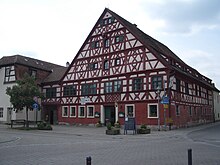
The area of today's district has always been rural. Agriculture, handicrafts and the village community determined the life of the population for many centuries. But the geographical location was favorable for the establishment of businesses from the start: the area is crossed by many rivers, which not only favored agriculture, but also drove various mills in the Middle Ages. This allowed craft businesses to develop early on. In the mills and solitary farms , some of which are still preserved today, iron was processed and glass and paper were made. One of these workshops has become a popular excursion destination: In the museum of the historic iron hammer near Eckersmühlen , visitors can still experience forging demonstrations of how iron was processed in the past. Many places in the district were already on important trade routes in the Middle Ages: the so-called Weißenburger Steig and the Würzburg-Regensburg road , for example, ran through the municipality . If traders traveled to Burgundy via the Ulmer Geleitstrasse or wanted to travel from Nuremberg to the trading city of Augsburg, they also had to cross today's district of Roth. The important trade route from Nuremberg via Munich to Venice led directly through the cities of Rednitzhembach and Hilpoltstein. The communities along the road benefited from travel. There were inns and customs stations, the sovereigns built castles and fortifications to secure the trade routes.
In the course of industrialization , the city, which has been the seat of the Hilpoltstein savings and loan association since 1911, gained importance through wire production: the manufacturer Wilhelm von Stieber founded the Leonische Drahtwerke , which manufactured Leonische Waren . The small company developed into one of the world's largest manufacturers of wires and cables at around 70 production sites.
Today the district of Roth is part of the metropolitan region of Nuremberg . Quite a few citizens commute to the city in the north every day, and Ingolstadt in the south also offers many jobs. However, medium-sized companies have also settled in the district communities over the past few decades. Corrugated cardboard and paper packaging, pumps and cables or precision parts for Eurocopter and Airbus come from the district, as do potato products known throughout Germany (Henglein in Abenberg) and hygiene articles.
The growth in companies and services is favored by the traffic situation: various federal motorways, federal highways, the Nuremberg-Munich train route and the Main-Danube Canal run through the district. The opening of the largest Bavarian armed forces base, the Otto-Lilienthal-Kaserne , in 1972 was beneficial for the economy of the district. There are currently around 29,000 jobs subject to social insurance contributions in the Roth district.
In agriculture today, two special crops play a role , especially in the Altland district of Schwabach : tobacco and hops . The town of Spalt has had the oldest hop seal since 1538 . The direct marketing is becoming increasingly important. The demand for regional products such as fruit, honey or pasta secures jobs for agriculture in the long term and at the same time makes a contribution to environmental and nature protection. In order to identify products from the region, the “Original Regional” trademark was founded in the Nuremberg metropolitan region in 1997. The goods are offered in so-called regional counters in many supermarkets in the district .
tourism
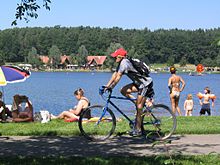
Since the mid-1990s, the Roth district has developed into an increasingly popular tourist area. Located in the Franconian Lake District, the communities benefit from the steadily growing number of visitors to the Roth and Brombach lakes . At the two artificially created lakes, locals meet with those looking for relaxation from the major cities in the area and holidaymakers. The Main-Danube Canal and the old Ludwig-Danube-Main Canal complement the recreational offer around the water.
The varied landscape between the Lorenzer Reichswald and the pre-Jurassic region of the Altmühltal nature park is particularly popular with hikers and cyclists: Numerous well-developed and signposted paths run through the entire area of the Roth district.
The fact that the towns and villages, all of which rely on gentle tourism , have largely retained their medieval or baroque appearance is also beneficial for the expansion of tourism . Castles, half-timbered houses, towers and (parts of) city walls still bear witness to the eventful past and are increasingly being explored by guests. The number of overnight guests has risen continuously in recent years. In 2006 the district already recorded 772,587 overnight stays.
The expansion of the tourism industry is financed by the European Union through LEADER + . Especially the Via Historica , a 130 km long circular tour with many churches, castles and palaces, brings tourists to the district. Other projects such as nature trails, museums and the “Experience Nature” network are used by locals as well as day-trippers and holidaymakers.
Health and social
District Clinic Roth
In 1984 the new Roth Kreisklinik was established, which has meanwhile taken over the basic and standard care for the entire district. A smaller hospital in Hilpoltstein ceased operations at the end of the 1990s and is now used as a retirement and nursing home. In the buildings of the old district hospital in Roth, the district office is now housed as the administrative seat of the district. In the meantime, the clinic has developed into a health center with 330 standard beds: In 2003, a medical and commercial building with a therapy center was added. A vocational school for nursing professions with 60 training positions is attached to the district clinic.
Auhof and Regens-Wagner Foundation
The Auhof is a district of Hilpoltstein that has merged structurally with the core town. It belongs to the Rummelsberger Anstalten and houses around 360 people with disabilities. The Auhof has a state-recognized support center with a focus on spiritual development , which is also connected to a school-preparatory facility and a day care center for special education.
The wood and metal products of the Auhof workshops, which are offered in the Auhof shop in the Hilpoltstein city center, are particularly well known in the district. The Auhof nursery also always has a lively clientele.
The Regens Wagner Foundations maintain an outdoor living group for deaf and dumb people in Zell , a district of Hilpoltstein . It is run by the Dillinger Franciscan Sisters . Schools, workshops and outdoor living groups should offer people with multiple disabilities a life that is as independent as possible. Other outdoor living groups in the district are located in Heideck , Marquardsholz (in Hilpoltstein) and in Offenbau (in Thalmässing ).
traffic
Streets
The district of Roth is crossed by the federal highways A6 , A9 and A73 , as well as by the federal highways B2 and B466 . There are also 248 km of state , 211 km of district and 1,100 km of municipal roads .
License Plate
When the new district was formed on July 1, 1972, the distinctive symbols HIP (for the Hilpoltstein district ) and SC (for the Schwabach district ) introduced in 1956 were used. On August 5, 1974, these were replaced by the new and still valid license plate RH . Since July 11, 2013, the distinctive sign HIP has been available again in the district of Roth.
Rail transport
The Kingdom of Bavaria opened the state main line Nuremberg – Treuchtlingen in this area as early as 1849, on which Schwabach and Roth are also located. In Roth, the local railway to Hilpoltstein – Greding, which is also state-owned, has branched off since 1888 - colloquially known as Gredl . The town of Spalt had already received a short branch line from Georgensgmünd in 1872 - popularly known as Spalter Bockl .
The local railways Feucht – Wendelstein and Burgthann – Allersberg brought rail connections to the main line Nuremberg – Regensburg from 1886 and 1902 respectively in the east of the district .
With the exception of the Roth – Hilpoltstein section, all local railways have been closed:
- 1955: Feucht – Röthenbach – Wendelstein 5.3 km
- 1969: Georgensgmünd – Spalt 7 km
- 1972: Greding – Thalmässing 12 km
- 1973: Burgthann – Pyrbaum – Allersberg 15 km
- 1974: Thalmässing – Hilpoltstein 16 km
The northern municipalities of the district have been connected to Nuremberg and Roth via an S-Bahn line since 2001. In 2006, the high-speed line Nuremberg-Munich was completed, which runs along the A9 through the district. With the regional train station near Allersberg, commuters to Nuremberg have since been connected to the R9 Express line and thus to Germany's fastest regional transport. In the same year, a cycle path was built on the former Gredl route Greding-Thalmässing-Hilpoltstein.
Main-Danube Canal

The Main-Danube Canal crosses the district over a length of 26 km on its way from Bamberg to Kelheim . In the district there are landing sites at Roth , the depot in Heuberg and outer ports at three locks . The Leerstetten , Eckersmühlen and Hilpoltstein locks are the highest locks in Europe with a lifting height of 24.67 meters. Shortly before the Hilpoltstein lock in the direction of the Bachhausen lock , the canal crosses the European watershed .
The canal is not only an important tourism factor, it is also of great economic importance: in 2006, 5,280 ships transported 6.24 million tons of cargo. With Hafen Nürnberg-Roth GmbH, the city of Roth participates in one of the largest cargo handling points on the Main-Danube Canal.
media
In the district of Roth there are two large daily newspapers in the print media sector: The Roth-Hilpoltsteiner Volkszeitung , a local edition of the Nürnberger Nachrichten , and the Hilpoltsteiner Kurier, the local edition of the Donaukurier in Ingolstadt. While the citizens of the southern district often read the Hilpoltsteiner Kurier due to its proximity to Ingolstadt, the Roth-Hilpoltsteiner Volkszeitung is more widespread in the northern district. There are also other local editions of the Nürnberger Nachrichten, such as the Schwabacher Tagblatt , the Hilpoltsteiner Zeitung and the Altmühl-Bote (local edition Gunzenhausen).
In the area of radio, in addition to the Bavarian and national radio stations, Nuremberg programs such as Hit Radio N1 , Radio F , Star FM , Energy Nuremberg or Radio Charivari 98.6 Nuremberg can be received in the district.
In the television sector, in addition to the public Bavarian television , the regional private television broadcaster Franken Fernsehen can also be received via cable, DVB-T and satellite.
Sights, art and culture
Attractions
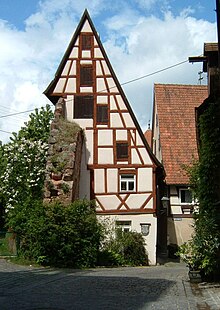
The district of Roth has many faces due to the different influences to which the cities, markets and communities were exposed. Early history , the Middle Ages, Baroque and Renaissance have all left their mark.
There are half-timbered houses worth seeing in almost every place. Particularly impressive examples are the Jahrsdorfer House in Hilpoltstein (a replica of the Albrecht Dürer House in Nuremberg), the Schlenzgerhaus , the Kornhaus and the Mühlreisighaus in Spalt . The landlords from the Middle Ages left behind impressive castles: Abenberg , Stauf and Wernfels Castle - the latter is now used as a youth hostel - are still completely intact. The Burg Hilpoltstein was used from the mid-17th century as a stone supplier for other buildings and therefore only sits in ruins above the town. In contrast, the former stately granary built in 1473 below the ruins is still completely preserved: today's so-called Haus des Gastes houses, among other things, an information center for the district of Roth as well as the library and the office for culture and tourism of the town of Hilpoltstein. An almost completely preserved city wall can be found in Greding. Almost all of the 21 towers are still inhabited by private individuals today.
Allersberg's market square is mainly characterized by Rococo buildings . The Gilardihaus , the Heckelhaus and the parish church Maria-Himmelfahrt were built at the beginning of the 18th century.
The parishes are particularly rich in churches in a wide variety of architectural styles. Romanesque , baroque, renaissance or margrave style alternate or sometimes even combine to form a building of its own. Among other things, the Sankt-Willibald-Kirche in Büchenbach is important . The former fortified church has late Romanesque designs in the basement of the east tower. The west tower, built in 1608, is unique: As a lot of hops used to be grown around Büchenbach, the roof space of the church served as a hop kiln ; The elevator for the harvested hops was in the tower . In Niedermauk (municipality of Röttenbach) the church of Saint Sebastian from the 14th century still exists today. It contains a statue of the Virgin Mary from the same period in the left side altar. The three statues of the high altar - Sankt Sebastian , Sankt Rochus and Sankt Laurentius - date from the 16th century.

There are castles in the district from various eras. The Castle Ratibor in Roth, which today is used inter alia as a meeting room of the City Council, museum, cultural center and restaurant, was 1535 to 1537. The Prince Bishop's hunting lodge in Greding is from 1696 and is now an antique shop. The rococo castle in Mörlach is privately owned and can be rented for parties. Kreuth Castle , which was mentioned in a document as early as 1335 , is enthroned on a hill near Heideck . The moated castle in Dürrenmungenau (Abenberg district) is still inhabited today.
Events, celebrations and festivals
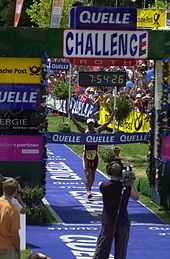
Every village in the Roth district celebrates Kerwa, Kärwa, parish fair, festival (patronage), village festival or folk festival according to its own traditions . The Hilpoltstein Castle Festival , which is celebrated annually on the first weekend in August to commemorate the arrival of Count Palatine Dorothea Maria, wife of Count Palatine Ottheinrich, in 1606, is particularly well known in the area . Hilpoltstein Castle was used by Dorothea Maria and her three daughters as a widow's residence . Through their charity, the city gained a certain wealth. That is why the people of Hilpoltstein celebrate this important point in their city's history not only with a four-day festival tent and a large flea market, but also let the story come back to life on Castle Festival Sunday: in the traditional festival and the subsequent pageant, in which hundreds of citizens in historical costumes take part, the move will take place the Countess Palatine re-enacted.
At the parade of the Heimatfest in Heideck , which takes place annually on the third weekend in July, numerous Heidecker in historical costumes parade through the streets. The town split commemorates every five years a special event in June 1450. At that time the Ansbacher Markgraf freed Albrecht Achilles with his cavalry gap from the siege of Nuremberg horsemen ( mercenaries ). For the 500th anniversary of the liberation, Friedrich Merkenschlager from the Georgensgmünder district of Hauslach wrote the home game Die Nürnberger Reis' , which has since been performed regularly by around 70 amateur actors from the Spalter population.
Cultural highlights are the New Orleans Festival in Wendelstein and the Rother Bluestage . The New Orleans Festival starts in the first week of May and attracts music lovers for nine days. The Bluestage in the Kulturfabrik Roth has been held since 1992 and brings international jazz and blues greats, such as BB King , to the city. Cultural events over several weeks have taken place every autumn in Hilpoltstein since 1992 under the title KultTour .
Since 1984 the district of Roth has been offering its own cultural program to complement the cultural offerings of the communities, churches and other organizations. Among other things, a Christmas concert and the concert event Young Artists Make Music , where young musicians from the two high schools in the district perform, take place every year. Further events are the day of the open studio , the district painting day or the local history themed year .
The sporting highlight in the Roth district is the Challenge Roth . The triathlon, which stretches across the southern district, brings around 4,000 starters - including numerous national and international greats - and more than 100,000 spectators from all over the world to the region every year. In addition to this long-distance triathlon (3.8 km swim, 180 km bike and 42 km run), the so-called Rothsee Triathlon has also taken place since 1989 . More than 1,000 triathletes take part every year and complete 1.5 km swimming, 42 km cycling and 10 km running.
At the end of January, the district's annual sports ceremony takes place. The event will take place in the sports hall of the Anton Seitz School Roth. Sports enthusiasts from the district are honored for special, national successes.
Instead of carnival , the communities in the Roth district celebrate typical Franconian carnival with “Flecklasmännern”, “Flecklashexen” or “Fleckli”. Strongholds are Allersberg with its traditional procession on Shrove Sunday and Spalt.
Art and literature
In addition to concerts, theater performances and sporting events organized by the district administration, the 16 cities, markets and municipalities as well as the numerous associations and groups, the art scene in the Roth district is particularly diverse and active. Time and again, private individuals or art associations such as SPECTRUM or the art meeting HIP organize vernissages , exhibitions and events related to art. The art directions range from painting, sculpture and photography to metal art, glass objects and flower art to ceramics, textile art and artistic interior design. The district of Roth promotes its art scene not only by organizing the open studio day : every year, the art exhibition offers an artist the opportunity to exhibit his life's work at Abenberg Castle.
In addition, the Roth district regularly awards the Elisabeth Engelhardt Literature Prize , which recognizes the work of the writers living in the district. Prize winners include Gerd Berghofer and Klaus Schamberger . Many writers are grouped together in the special time group. The youth culture award also provides special support for committed young people .
Museums
Many of the museums in the localities of the district deal with the city and regional history. The prehistory and early history museum Thalmässing is worth mentioning . It houses exhibits from the historical past - from the Stone Age through the Bronze and Iron Ages to the time of the Great Migration. The archaeological hiking trail is connected to the museum and leads to eleven stations of prehistoric and early historical settlement in the Thalmässing area over 15 kilometers. On the archaeological hiking trail, the hiker also arrives at the historical village near Landersdorf , which shows the reconstruction of a Celtic and Stone Age house as well as an early historical garden in which old types of grain such as emmer , spelled and einkorn are grown. Once a year the Celtic Festival revives the life and work of the ancestors.
In the historical iron hammer museum near Eckersmühlen , visitors can experience forging demonstrations in the old forge hall , how square nails were made in earlier times with the help of heavy tail , drop and air hammers . In the manor house built in 1699, the fully preserved interior of the last resident, Fritz Schäff, testifies to the pronounced sense of class of the hammer lords. The permanent exhibition From ore to iron in the former sawmill shows the diversity of the iron topic , from replica mine tunnels to models of a coal pile and a racing furnace to chain mail , knight armor and modern works of art.
In the house of Franconian history at Abenberg Castle, the permanent exhibition "A journey through Franconia" keeps life in a medieval castle alive and provides information about historical events in the region. The Abenberg Lace Museum, which is also housed in Abenberg Castle, keeps the centuries-old tradition of lace in memory.
The factory museum in Roth, which deals with the production of Leonese goods, was awarded the Bavarian Museum Prize in 2003. In Georgensgmünd the Jewish Museum , the synagogue and the Jewish cemetery bear witness to the fact that from the middle of the 16th century to 1938 a large part of the Georgsgmünd population was Jewish.
Cultural monuments
There are numerous stone crosses in the district, most of which are also listed as architectural monuments .
Protected areas
In the district of Roth there are nine nature reserves , three landscape protection areas , three protected landscape components , 75 natural monuments , 3 extensive natural monuments, twelve geotopes , five FFH areas and a nature park (as of March 2016).
See also:
- List of nature reserves in the district of Roth
- List of landscape protection areas in the district of Roth
- List of protected landscape components in the district of Roth
- List of geotopes in the district of Roth
- List of FFH areas in the district of Roth
Nature reserves
- Stream and gorge forest near Untermässing
- Kuhbachtal near Hausen
- Northwest bank of the Rothsee main barrier , Rothsee
- Sägmühle , Brombachsee
- Schwarzach Gorge near Schwarzenbruck
- Reservoir root of the Rothsee , Rothsee
- Thalachwiesen near Thalmässing
- Schwarzachwiesen bird sanctuary near Freystadt
- Bird sanctuary Kauerlacher Weiher near Karm
literature
- District of Roth (ed.): Local history forays. Vol. 1 ff., 1982 ff. ISSN 0724-1100 .
- District Office Roth (ed.): Our district of Roth. A brochure from the district. Bayerische Verlagsanstalt Bamberg, Bamberg 1995, ISBN 3-87052-966-0 .
- WEKA / District Office Roth (ed.): District of Roth. Business location. WEKA info Verlag, Mering 2005 (PDF; 3.37 MB).
- District Office Roth (ed.): The district of Roth, what was - what is - what connects us. A home book of the district. Roth 2009, ISBN 3-924160-10-4 .
Web links
- Website of the District Office Roth
- News, photos and news about nightlife in the district
- Literature from and about the district of Roth in the catalog of the German National Library
- Entry on the coat of arms of the district of Roth in the database of the House of Bavarian History
Individual evidence
- ↑ a b sheet "Data 2", Statistical Report A1200C 202041 Population of the municipalities, districts and administrative districts 1st quarter 2020 (population based on the 2011 census) ( help ).
- ↑ See also list of Frankish knight families # H
- ^ Wilhelm Volkert (ed.): Handbook of Bavarian offices, communities and courts 1799–1980 . CH Beck, Munich 1983, ISBN 3-406-09669-7 , p. 97 .
- ^ Ordinance on the reorganization of Bavaria into rural districts and independent cities of December 27, 1971
- ↑ District Administrator and Deputy. (No longer available online.) District Office Roth, archived from the original on January 28, 2015 ; Retrieved January 25, 2015 . Info: The archive link was inserted automatically and has not yet been checked. Please check the original and archive link according to the instructions and then remove this notice.
- ↑ name = "District election 2020"> Preliminary result for the district election 2020 on March 15th, 2020. District Office Roth, March 16, 2014, accessed on June 18, 2020 .
- ↑ Entry on the coat of arms of the district of Roth in the database of the House of Bavarian History , accessed on September 5, 2017 .
- ↑ Sponsorship in the Saaz homeland. District Office Roth, accessed on January 26, 2015 .
- ^ Partnership Roth - Borough of Brentwood. District Office Roth, accessed on January 26, 2015 .
- ↑ Future Atlas 2016. (No longer available online.) Archived from the original on October 2, 2017 ; accessed on March 23, 2018 . Info: The archive link was inserted automatically and has not yet been checked. Please check the original and archive link according to the instructions and then remove this notice.
- ↑ a b Sport and Hop: What you need to know about the Roth district. Retrieved January 13, 2020 .
- ↑ Housing offer. Rummelsberger Diakonie , accessed on August 3, 2014 .
- ↑ Bayerischer Rundfunk: Map: Course of the European main watershed. October 24, 2011, accessed August 3, 2020 .
- ↑ Honor for athletes. District Office Roth, accessed on January 23, 2015 .


